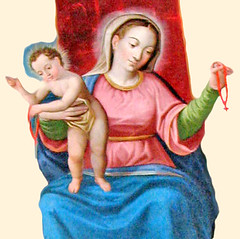Christ's Thirst for Us
 Station at Saint Lawrence-without-the-walls
Station at Saint Lawrence-without-the-wallsThe Station today is made at San Lorenzo fuori la mura, one of the five patriarchal basilicas of Rome, where are buried the bodies of the two deacons Lawrence and Stephen. Constantine the Great was the first to erect a little oratory over his burial-place off the Via Tiburtina in the Catacomb of Cyriaca. This was enlarged and beautified by Pope Pelagius II (579-90). Pope Pope Sixtus III (432-40) built a large basilica with three naves, the apse leaning against the older church, on the summit of the hill where he was buried. In the 13th century Honorius III made the two buildings into one, and so the basilica of San Lorenzo remains to this day, albeit rebuilt after World War II. It is reckoned as a major basilica because it is specially attributed to the Patriarch of Jerusalem, who was resident here from 1374 - 1847, and so it ranks with the four papal major basilicas.
The Gospels for the this Sunday of Lent and the following two Sundays are primarily the three great Lenten Gospels taken from St John. They each have a special Lenten Preface that is used during the Mass when they are read. These readings are chosen to accompany the Rites of Scrutiny that were part of the catechumen's journey towards baptism on Easter Sunday; they are still used in the Rite of Christian Initiation for Adults (RCIA) and express the growing enlightenment and purification of the catechumen who is being prepared for baptism.
The Gospel of the Samaritan woman (Jn 4:5-42), read today, is a model of catechesis as Christ draws the inquiring woman from befuddlement to faith in Him. The Gospel of the Man Born Blind (Jn 9:1-41), read on the Fourth Sunday of Lent at the Second Scrutiny, expresses the enlightenment of the catechumen through that faith in Christ, who opens his eyes to Truth. The Gospel of Lazarus (Jn 11:1-45) is read on the Fifth Sunday of Lent at the Third (and final) Scrutiny and is a foretaste of the rewards of baptism and faith in Christ, which is to be brought from the "living death" of sin to new life in Christ.
"The thirst of Jesus was a thirst that the Samaritan woman could not satisfy by water from Jacob's well but only by giving him her heart, her love, her faith. He was thirsting for her faith as we in the Preface at Mass today... First comes this thirst and the longing of the Lord for us...
He starts from where he is, from where others see him. In the case of the Samaritan woman he meets her as one with needs, but she meets him as a person with needs herself. In her we see ourselves. It is not necessary to start out with particular profound or super-refined needs in order to make contact with Jesus. He merely happens to be there when a person is seeking to fulfil and satisfy the needs of the moment, however trivial or however deep they may be. The Samaritan woman in need of water goes to the well like going to the shop to get an ounce of tobacco, and there he is. Yet from the point of view of Jesus this is not in fact casual or chance. He has been sitting there waiting for her...
Jesus and the woman started to talk. The conversation turned to what he and she really wanted... How she wanted things! It was because she wanted things so much that she finally found everything she could possibly want. It was because her wants were so strong and so fierce that she found everything she could ever have wanted and so much more. Coming to Jesus will not work if you have little desire. It will work if you have some emotion and passion, some fire in your guts. 'Does he really seek God?' is the basic question according to the Rule of St Benedict...
The story of the thirst of the Samaritan woman is meant to make us want things more, to want with a depth and an intensity like that of the thirsty man when the dehydrated tissues of his body cry out to be slaked. This woman who stands for us finds God on the basis of wanting fiercely whatever it is that she does want, and then discovering that the homing point of all her firece desire is Jesus. 'What do you have to do to become a saint?' St Thomas Aquinas was asked. He replied in a word: 'Velle, want it!'"
Let us make our own the Prayer over the Catechumens from the First Scrutiny:
you sent your Son to be our Savior.
Grant that these catechumens,
who, like the woman of Samaria, thirst for living water,
may turn to the Lord as they hear his word
and acknowledge the sins and weaknesses
that weigh them down.
Protect them from vain reliance on self
and defend them from the power of Satan.
Free them from the spirit of deceit,
so that, admitting the wrong they have done,
they may attain purity of heart
and advance on the way to salvation.
We ask this through Christ our Lord."
Amen!
The beautiful fresco above is from the catacomb on the Via Latina and dates to the mid-4th century.







1 Comments:
Thanks Miya. I am a novice and have completed half my novitiate. I'm afraid I can't post often about my experiences as such matters involve the whole community and would go beyond the bounds of discretion and require approval from my superiors.
I also prefer to focus this blog on Christ and his Gospel rather than on myself.
Thanks.
Post a Comment
<< Home